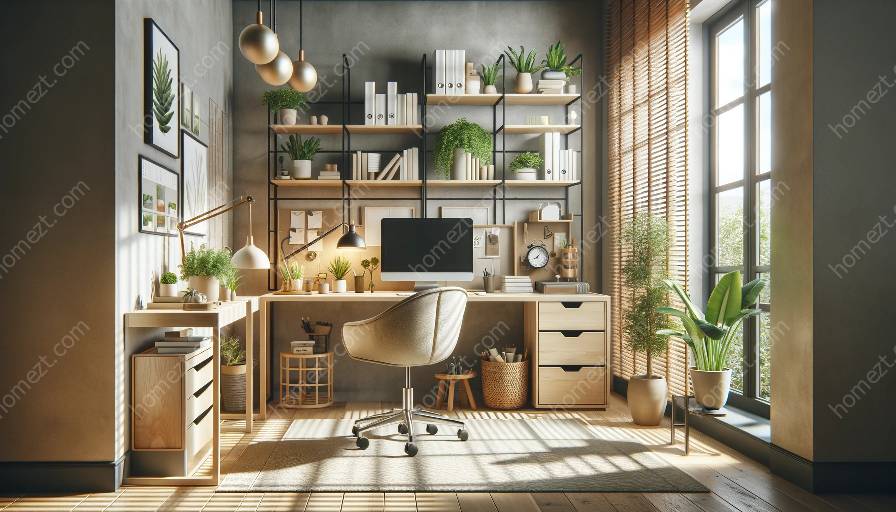Lighting plays a crucial role in creating an effective study environment. The right lighting can significantly impact productivity and focus in a study room. This topic cluster will explore the correlation between lighting and productivity, and discuss how to incorporate appropriate home office and study room designs to create an optimal setting for learning and work. Additionally, we will delve into interior design and styling techniques to enhance the functionality and aesthetics of study spaces.
Understanding the Relationship between Lighting and Productivity
Research has shown that lighting has a profound impact on productivity, mood, and overall well-being. In a study room, the quality and quantity of light can greatly influence an individual's ability to concentrate, retain information, and stay motivated. Harsh or inadequate lighting can lead to eye strain, fatigue, and reduced productivity, while proper lighting can create a conducive environment for learning and working.
Types of Lighting and Their Effects
There are three primary types of lighting: ambient, task, and accent lighting, each serving a different purpose in a study room.
- Ambient lighting provides general illumination and sets the overall mood of the room. Soft, diffused ambient lighting can create a calming atmosphere, ideal for promoting focus and concentration.
- Task lighting is designed to illuminate specific work areas, such as a desk or reading nook. Adequate task lighting helps reduce eye strain and enhances the ability to perform detailed tasks, such as reading, writing, or using a computer.
- Accent lighting highlights particular features or focal points within the room, adding visual interest and depth to the space. While not essential for productivity, well-placed accent lighting can enhance the overall ambiance and aesthetic appeal of the study room.
Implementing Effective Lighting Design in Home Offices and Study Rooms
When designing a home office or study room, it is important to consider lighting solutions that promote productivity and comfort. Here are some practical tips for implementing effective lighting design:
- Natural Light: Maximize natural light by positioning study areas near windows or incorporating skylights. Natural light is not only beneficial for productivity but also contributes to a healthier and more pleasant study environment.
- Adjustable Lighting: Opt for adjustable desk lamps or overhead fixtures that allow you to control the intensity and direction of light. This flexibility enables you to adapt the lighting to different tasks and preferences throughout the day.
- Layered Lighting: Combine ambient, task, and accent lighting to create a balanced and versatile lighting scheme. Layered lighting provides the flexibility to adjust the lighting according to specific activities and creates a more visually appealing space.
- Color Temperature: Choose light sources with appropriate color temperatures. Cool white light (4000-5000K) can enhance alertness and focus, making it suitable for task-oriented activities, while warmer light (2700-3000K) can promote relaxation and comfort for reading or studying.
- Smart Lighting Solutions: Consider integrating smart lighting systems that allow you to customize and automate lighting settings based on your daily routines and preferences. Smart lighting can enhance convenience and energy efficiency while optimizing the study environment.
Integrating Interior Design and Styling for Enhanced Study Spaces
Besides lighting, interior design and styling play a vital role in creating functional and visually appealing study spaces. Here are some interior design and styling tips to optimize the study room:
- Ergonomic Furniture: Invest in ergonomic and adjustable furniture, such as a comfortable chair and a well-designed desk, to support proper posture and enhance comfort during long study sessions.
- Storage and Organization: Incorporate sufficient storage solutions, such as bookshelves, cabinets, or wall-mounted organizers, to keep study materials and supplies neatly organized and easily accessible.
- Comfortable Flooring: Choose flooring materials that offer comfort and acoustic insulation, such as cork or carpet, to create a conducive study environment. Additionally, using area rugs can add texture and warmth to the space.
- Personalized Decor: Integrate personalized decor elements, such as artwork, motivational quotes, or plants, to infuse the study room with personality and inspiration. Thoughtfully selected decor can contribute to a stimulating and uplifting atmosphere.
- Functional Layout: Optimize the layout of the study room to ensure efficient circulation and access to essential study tools. Consider the placement of furniture, lighting, and storage to create a well-organized and inviting space.
- Aesthetic Harmony: Strive for a cohesive and harmonious aesthetic by coordinating colors, textures, and decorative elements throughout the study room. A visually appealing environment can enhance motivation and create a pleasant study experience.
Conclusion
The impact of lighting on productivity in a study room cannot be understated. By recognizing the influence of lighting on learning and work performance, and implementing effective home office and study room designs, individuals can create an environment that maximizes productivity and fosters an enjoyable study experience. Moreover, integrating interior design and styling principles can further elevate the functionality and allure of study spaces, resulting in optimal settings for personal growth and achievement.


























